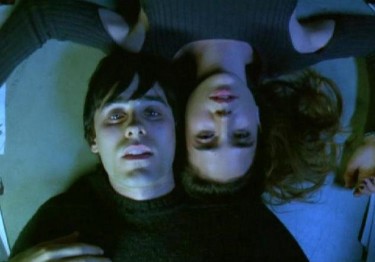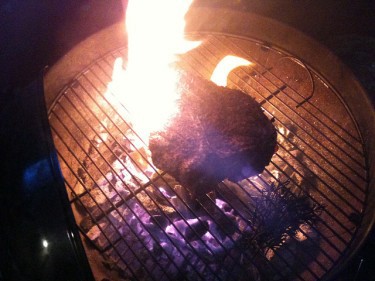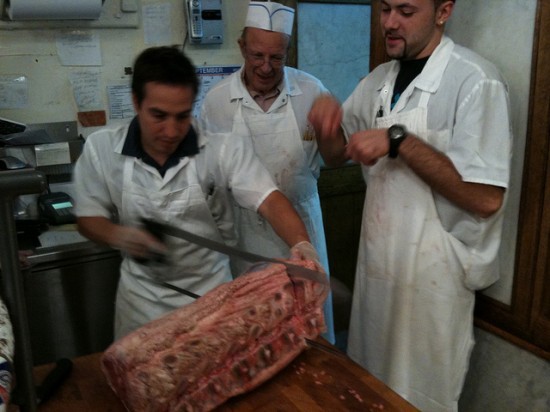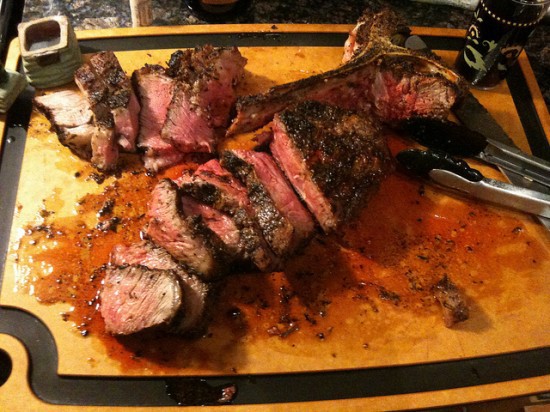But You Can Understand How The Mistake Was Made
“A capsule summary on Wednesday for a news analysis article about Greece’s persistent economic problems misidentified the people who are growing more reluctant to continue paying the country’s bills. They are Greece’s lenders, not its leaders.”
Oh Did You Get Rained On? You Poor Thing
WE MADE IT THROUUUUUGH THE RAIN. But not without lots of endless complaining and Instagram filters. (iTunes)
The Sound Of 'Requiem For A Dream'
by Sharan Shetty

It’s been 12 years since Harry Goldfarb, Marion Silver, and Tyrone Love burst on screen in pursuit of a pound of pure and no hassles. Since then, Requiem for a Dream has achieved that rare distinction of being a low-budget, high-impact movie, the quintessential cult hit. It solidified director Darren Aronofsky’s wunderkind reputation, one later buttressed by the critical successes of The Wrestler and Black Swan. It redefined what a “drug movie” could be, illustrating brutal addiction despite the word “heroin” never being uttered in its 101-minute running time. It subverted film grammar, challenged the mechanics of narrative, and influenced filmmakers wide and legion.
All this has been observed and repeated ad infinitum over the past decade. What’s escaped admiration is the experimental and incredibly effective sound design that permeates the film. Though the soundtrack has been recognized — most notably Clint Mansell’s Lux Aeterna overture, which has been recycled in droves of trailers — the influence of the movie’s actual sound work has been underappreciated.
Sound design is perhaps the most overlooked art in cinema, and for good reason: truly perfect sound serves only to enhance immersion in the film. It’s not supposed to draw attention. But once you start paying attention, Requiem’s scenes are riddled with subtle, striking enhancements, from the hallucinated growl of a character’s refrigerator to the grating teeth-grinding of an addict on uppers. I talked with Nelson Ferreira, supervising sound editor of the movie, to discuss what went into making the film’s sound.
What was your role in the film?
Well, I was the supervising sound editor, so I basically headed the team that did all the sound for the movie. Everything except the musical score, of course, which was performed by the brilliant Kronos Quartet. I communicated directly with Darren, talked through the ideas we had for the film, and communicated those ideas to the crew. I make it sound like a big crew, but it was actually like four people. It was a low-budget movie, a low-budget crew, but a very high-quality movie.
There’s not a lot of silence in the movie. It’s a relentless aural experience, right from the cold opening of Ellen Burstyn locking herself in the closet. How did a movie like this compare with your other work?
That’s a good question, and I’d have to give a multi-part answer. Firstly, it dealt on a psychological level that a lot of films don’t. It was way beyond the scope of the sound psychology of most movies. It wasn’t rudimentary ABCD stuff like trying to narrow down who the villain might be. We really had to think between the lines. And, in that regard, I really have to give the credit where it’s due, which is mainly with the director. Darren has a way of reading between the lines and finding the psychology and psychosis within the story that most people just wouldn’t see. He brought that out of us, he pushed us to frontiers that we hadn’t been to before. Quite honestly, we had never been afforded the opportunity to do it. Even most big Hollywood movies are pretty two-dimensional in terms of sound, and Darren just opened a door. Not just for us, but for a lot of filmmakers.
There are really two worlds in the movie, two parallel storylines. You have the son and the mother; there’s Jared Leto and Jennifer Connelly’s descent into heroin addiction and Ellen Burstyn’s diet pill delusions. Did you try to differentiate those two narratives through sound in any way?
Hmm. I’m not sure I would say differentiate necessarily; both narratives were definitely different motifs. We actually focused on segueing them pretty seamlessly into each other to draw the parallels between those two worlds. I would say that Jared and Jennifer’s world is very much from their point of view looking out. With Ellen’s world, it was much more imbued with a sort of eye-in-the-sky feel. You had that the corner-of-the-room perspective, personified by the television set and the refrigerator. That was a perspective to which sound designer Craig Henighan gave so much personality and life. So converging those two worlds was really a priority for us.
And in terms of conceiving those ideas, it comes back to Darren. He says, quite literally: “Give me everything you’ve got. Every idea, bring it to the table. There’s probably a 10% chance I keep it, but if I do, it will be the best work you’ve ever done.”
You mentioned the fridge. The way it manifests as this eerie imposter in Ellen’s hallucinations is brilliant. There’s so much going on there, it almost becomes a character.
It was just one of those things that goes to show how much the art of sound design is changing, way beyond what the term meant 20 years ago. Now it’s the art of taking the sounds of everyday things and shaping them, stretching them with pitch or by clever placement, and giving them different meaning or an emphasis they otherwise wouldn’t have. The fridge is really a very simple thing. It’s just a matter of the fridge you choose — no two fridges sound alike. If we had taken a fridge which was just a Westinghouse or Whirlpool made a year ago, it would sound like a well-oiled machine. It wouldn’t have had the same impact. You need something that has an old compressor, that really growls, that’s what gives it character. We’re always referring to personality. Everyone wants personality. It’s the courage to try something different that gives it a different feel.
Sarah Goldfarb, played by Ellen Burstyn, recoils in fear of her refrigerator.
One of the more novel aspects of Requiem is its use of “hip-hop” montages, rapid-fire sequences used to compactly show the characters shooting up or entering the illusory world of their drug high. How did your team approach the sound design in those sequences?
It’s interesting you call it “hip-hop”, because that’s exactly what Darren called it. Those were actually the first things they showed us. Darren has worked for quite a while with an absent-minded-professor type named Brian Emrich, a sound designer in New York. They’ve been working together since some of Darren’s more indie stuff, like Pi. Throughout the filming of Requiem, Brian would feed him little things for those sequences. So those things actually developed during picture editing. Even before sound editing, the basic concepts of those hip-hop sequences had been delivered to us. What we did in the sound editing process is refine things like the dilating pupil, that sort of thing, to raise the level of the sound and give it a larger and more cinematic feel. What we received were essentially sketches, but even Brian and Darren’s sketches gave such great direction. They required no verbal description. It was immediately like, “O.K., I know what he’s trying to do.” He’s trying to create something, trying to use these transitions to echo the drug rush, to really capture the heroin rushing through the veins.
The “hip-hop” sequences that recur every time a character consumes or injects a drug.
I’ve seen Aronofsky mention placing the sound of an airplane passing overhead in the background of those sequences. He got the idea after being inspired by jumbo jets flying over New York from JFK. How often do you use sounds that “don’t belong?” In other words, how devoted to realism were you in the project? It’s a movie with lots of surreal and absurdist overtones, so how do you deal with that as a sound designer?
I’ll go on a limb and say that it’s common for good sound designers to do. Which lends itself to what I was saying before: intelligent choices of sound don’t necessarily fit, but they always have some sort of impact. The sound of say, a jet, the rising tension of it, is maybe exactly what’s required to make that impact — to say here’s the heroin, here it goes into the body’s system. The sound itself is so dynamic; it has that push, that rush of moving air to it. We routinely do stuff like that, where you’re juxtaposing things. Sometimes trying to jam a square peg in the round hole is exactly what you need.
Yeah. So much of the film is rooted in repetition, in a kind of cycle anchored by Clint Mansell’s Lux Aeterna overture. There are periods of calm, then periods of drug-addled frenzy. Was that cycle kept in mind during sound design?
Absolutely. Again, that’s what good designers do. They find a way of drawing a straight line through the movie. Good designers watch a piece and try to figure out what’s trying to be said. What’s the common theme, in terms of story? Where can I draw a line? Sometimes that straight line is on an upward curve in terms of tension — that’s where the fridge and airplane sounds come in. In television, where there isn’t time to live with a project and find that theme, it becomes very paint-by-numbers. In terms of placing sounds, they say, “here’s the scene, we’re in a park, here’s the bird, here’s the car, next.” It might be unfair to label all of television this way, but in general it just doesn’t provide the broad canvas needed. With movies, you can find something to hitch your wagon to and really ride with it.
You and the sound crew were nominated for a Golden Reel from the Motion Pictures Sound Editors, but overlooked for an Oscar nomination. I’ve talked to other sound editors, many who think the Oscar snub was unfair. Thoughts? Do you think sound design, in general, is unfairly evaluated, or does most quality work get its rightful recognition?
You know what, that’s a really good question. I might give a somewhat biased answer: I’m this random guy who works up in Toronto, so I’m somewhat detached from the Hollywood machine. I do the occasionally Hollywood movie, but mostly outside stuff, hopefully stuff like Requiem. Awards can be incredibly biased based on membership, who’s voting for whom, etc. Usually the nominees have reason to be there and deserve a nod. I helped with Black Swan as well, and in that case the Canadian crew can only take on a limited role. Most of the sound design there was done in New York, a lot by Craig Henighan. And in the case of Black Swan, a lot of people told me personally it should have been Oscar-nominated for its sound work. I agree, and I think there was probably some West Coast bias in the nominee selection. As an Academy member voting in that category, you’re more likely to be in tune with the people you work with in your community, which is most likely a Hollywood community. There’s nothing inherently wrong with that, but it’s just how it works. It might be the same thing with me — I’m not saying I vote for people I know, but when it comes to local sound designers in my area, I’m more aware of the struggle it took to make their work, so I have more appreciation for it.
Understandable. In closing, what’s your favorite memory from the movie?
Personally speaking, it would be the first morning I had with Darren Aronofsky. When we first sat down, he verbalized what he was looking for more eloquently than any other director I’ve ever met. He was 30 years old, he had made one low-budget feature, but he was confidently and succinctly describing what he wanted. And the little things he was describing, the “this here, that there”, were just putting off little lightbulbs in my head. The vision was so surprising and detail-oriented, and it’s very rare that you see that in directors.
Related: 23 Terrific Movie Studio Bumpers
Sharan Shetty is an Awl summer reporter.
Your Dad Is Right About Your Crappy Music: Science
“A group of researchers undertook a quantitative analysis of nearly half a million songs to look for widespread changes in music’s character over the years. The findings, published online July 26 in Scientific Reports, show that some trends do emerge over the decades — none of them necessarily good.”
A Poem By Leigh Stein
by Mark Bibbins, Editor
How to Read the Secret Language of the Pharaohs
I am afraid that if they build a sarcophagus
exactly to your measurements and then
invite you to a party, the sarcophagus
will be there and you will climb inside
and fit and then they’ll shut the lid
and throw you into the river and you
will drown and what will I do then?
I couldn’t sleep alone after I saw the movie
about the chariots and bloody ostrich hunts,
in which one man kills his brother and the wife
of the dead one has to wander around the desert
until she has picked up every piece of his body
and put them back together with the magic
tricks she knows. He doesn’t live, but
he does get to go to the underworld, and the rest
of the movie is all about her life as a priestess
because when she asked if she could go with
him he said no, but I know that if I put you
back together I would follow you
to the underworld even if you said
you didn’t want me to, even if you said
there were not enough seats in your chariot
or riverboat or rickshaw because when two
people spend as much time together in a small,
enclosed space such as we have in this one,
they will follow each other to future small,
enclosed spaces. This is a pretty long book
inscription, but when you leave I want you
to keep this with you at all times, in case
you need a curse, a lament, a mirage
or incantation. To speak the name of the dead
is to make them live again. I will never forget
when I was just your sister in the acacia
tree of our childhood and at night the chariots
and thrones and arrows and birds and twins
in the stars foretold our future ruin. I’ve heard
it said that he who loves you swallows stones
for you while your enemy waits for you
to birth a son to avenge his father’s death
by causing a tempest to flood the earth.
Leigh Stein is the author of the novel The Fallback Plan, and a new poetry collection, Dispatch from the Future, both from Melville House.
There’s a big ol’ thing of more poems right here, in The Poetry Section’s archives. You may contact the editor at poems@theawl.com.
Old People Inscrutable, Wrinkly
“A new study suggests that younger people may make more mistakes when judging the emotions of older folks. To younger adults, age-related changes, such as wrinkles and folds, look like facial expressions, so they may interfere with the perception of emotion in an older face and perhaps convey the wrong message.”
T-Bone, For Two
by John Ore

A series on things to make, eat and imbibe this summer.
You know what? Forget about groups and gatherings. Enough with the ever-faithful host to the hordes, the slaving over the hot grill for others just to watch them bogart all of your ribs. Deep into the dog days of summer, it’s time to slow down and relax with a somewhat indulgent meal. Save it for one of those summer Saturday nights when you have nothing planned and nowhere particular to go. Sometimes a delightful summer evening requires nothing more than you and your sweetheart. And a huge hunk of beef.
Main: T-Bone Fiorentina
Sides: Grilled ramps and new potatoes
Booze: Northern Minnesota beer or Southern French wine
T-Bone Fiorentina
1 t-bone steak, about 3 inches thick (3 to 3 1/2 pounds)
1 tbsp chopped fresh rosemary leaves
1 tbsp chopped fresh sage leaves
1 tbsp fresh thyme leaves
2 tbsp freshly ground black pepper
2 tbsp kosher salt
2 tbsp olive oil
Serves 4–6
Let’s be sure to start off with a quality piece of meat. It won’t be cheap, but it’s worth it, and you should end up with enough leftovers to get a few meals out of it. Best bet is to have a pro carve you off a nice three-inch-thick t-bone steak from the sub-primal loin. Depending on where from the loin your steak is cut, it will have a varying amount of the tenderloin (filet mignon) on one side of the bone, with the strip steak on the other. This is the primary difference between the t-bone and the porterhouse: the porterhouse has more tenderloin, which a leaner, more tender, but less flavorful cut. Just tell your butcher which you prefer; they’ll usually ask.

Once you get the beast home, pat the steak dry with paper towels. In a small bowl, mix together the rosemary, sage, thyme, black pepper, and kosher salt. Rub the entire steak with the herb and seasoning mix, coating thoroughly, and brush with olive oil to help it stick. As with most steaks, you’ll be using a direct grilling method for this one, so place the meat on the grill directly over hot coals. Cook, covered with the vents wide open, for 20 minutes: around 12 minutes on the first side and 8 on the second. With the fiorentina, we’re looking for a nice crust and meat on the rarer side, so adjust the cooking time to suit your tastes.
Let stand 5–10 minutes before carving. Slice the meat away from the center bone and then cut into hearty ½ inch slices for serving. I won’t tell if a slice or two goes missing during the process.

Grilled Ramps
Yeah, yeah, yeah, ramps are all trendy and Brooklyn, like kale. They are also super easy to grill, and a delicious complement to grilled beef. They are so flavorful that you just need to toss them with a little kosher salt, ground black pepper and olive oil, then fuss ’em on a grill pan until they start to brown a bit. Ramps are also delicate and can burn easily, so you probably only need about a minute or two a side.
Grilled New Potatoes
Upholding the other half of the traditional meat-and-potatoes pairing, potatoes always have a place on the grill. Scrub and quarter some new potatoes — be sure to leave the skins on, that’s where the vitamins are! — and toss with olive oil, kosher salt, ground black pepper, whole rosemary leaves and maybe some chopped garlic. Throw them in a grill pan or cast iron skillet over direct heat, tossing frequently to prevent them from getting too charred. You can boil the potatoes beforehand to cut down on the cooking time, finishing them on the grill.
Booze
While I’m always going to reach for red wine first when I even think about a steak like this (never before noon, though), I can think of a few beers that would also stand up nicely next to grilled beef. I had a Dubrue India Black Ale on a hot night in Duluth, MN, recently and it was pretty awesome. Toasty, malty, maybe a little chocolatey, with some nice hoppiness that would go well with the charred herb crust on the t-bone. I can even see a Guinness or Fuller’s working well with steak on a summer night, toasting the Olympics.
But this dish is just for the two of you, and staring deep into each other’s eyes over a plate of beef and a bottle of Southern Rhone wine just sounds dreamy, doesn’t it? Something like a Châteauneuf-du-Pape may sound cliche and maybe a little pretentious, but it’s dynamite paired with, you know, a freakin’ three-inch-thick t-bone steak. It just works. Plus, you’re only sharing it with the one you love. If you blew everything on the beef — which, if you are prioritizing, is the right decision — you can find plenty of reasonably-priced, tasty wines from Languedoc, with the meat-friendly Cabernet and Merlot grapes mingling with the more interesting Mourvedre, Grenache, Syrah, Cinsault and Carignan varietals.
Or skip the booze. You’ll be meat-drunk anyway.
Previously in Hot For Summer: A Menu For Shrimp On The Grill, Ribs, For Their Pleasure and How To Make Beer Ice Cream
John Ore’s motto has always been “You and me and t-bone makes three.”
When I Come Home To You, San Francisco, I'm Gonna Shit Wherever I Can See
“While the sheer volume of human waste was surprising, its presence was not.”
The Three Little Bears And The Great Dumpster Escape
So: “Three Baby bears got stuck in a dumpster over night. Mama bear sat by the dumpster all night listening to her cubs cry. Shirley and Tom Schenk, help three bear cubs escape from a dumpster in Ruidoso, N.M.”
Related: Big thanks to all of you who have been passing along the links to these bear cam feeds. They are prime bear-watching experiences!
Say Hello To Your Scorpion Roommates
“[The current weather pattern] means perfect conditions for a host of pests including fleas, ticks, termites, mosquitoes, brown recluse and black widow spiders and scorpions to flourish in the coming weeks. What’s worse, the hot, dry temperatures will eventually drive those pests to seek out moisture and cool places to dwell — like homes.” [Via]
